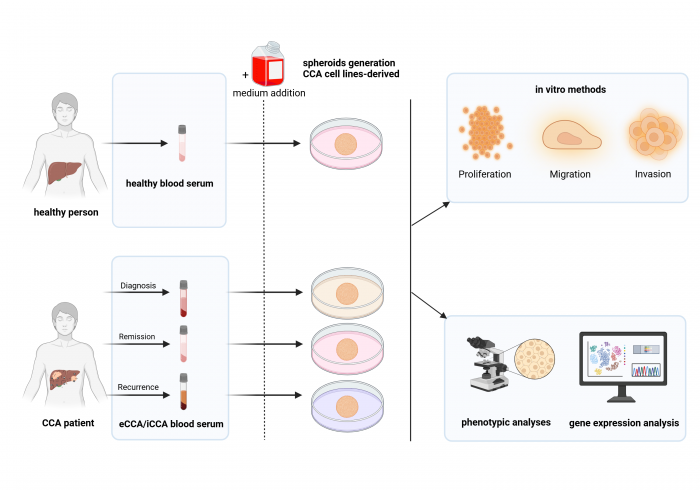P16-3: Screening for systemic factors in biliary diseases
Nora SiegeltPhD Student
Verena Keitel-AnselminoProject Leader |
Cholangiocarcinomas (CCAs) are a group of highly lethal bile duct cancers that arise mostly in the extrahepatic region (eCCA) from the biliary epithelium. The incidence of CCA and the global mortality rate are steadily increasing. Despite advanced therapeutic approaches, the long-term prognosis is dismal with high recurrence rates. Therefore, it is essential to better understand the underlying biology of these tumors in order to define novel therapeutic targets and approaches. In this project, we are investigating the role of systemic factors on tumor behavior using CCA patient sera. The effects of blood components on the intrahepatic biliary epithelium (iCCA) and the extrahepatic biliary epithelium in eCCA will be examined using 3D spheroid models, designed to replicate malignant tumor cells. The iCCA/eCCA spheroids will be treated with serum-derived factors including proteins, cytokines, circulating nucleic acids and metabolites. Serum samples will be collected from patients at different stages of the disease, which will allow us to analyze the dynamics of various serum-derived factors in tumor progression. The effect of sera on the proliferation, migration and invasion of spheroids will be analyzed in vitro. For examination of spheroid proliferation, 3D cell viability will be investigated using an ATP Assay and a variety of proliferation markers (e.g. Ki-67, PCNA, c-Myc) by qPCR. To evaluate the impact on spheroid migration, the area of cells emerging from the spheroids will be measured using the Fiji ImageJ software. To determine the effects of sera on spheroid invasive abilities, the area occupied by spheroids within the Matrigel will be measured. Furthermore, phenotypic changes in the shape and size of the spheroids will be assessed. Transcriptomic analyses will be performed to determine changes in gene expression of iCCA and eCCA spheroids by RNAseq and where possible compared to the patients tumor sample. In addition, the biochemical environment of eCCA and iCCA will be analyzed in more detail using LC-MS/MS and the influence of circulating bile acids and expression of different bile acid receptors will be determined. By combining advanced 3D spheroid models and patient-derived blood sera as along with the application of functional assays and gene expression studies, this study aims to deepen our understanding of CCA pathogenesis and provide an approach for the development of new therapeutic strategies.
|
Photos: by UMMD, Melitta Schubert/Sarah Kossmann








